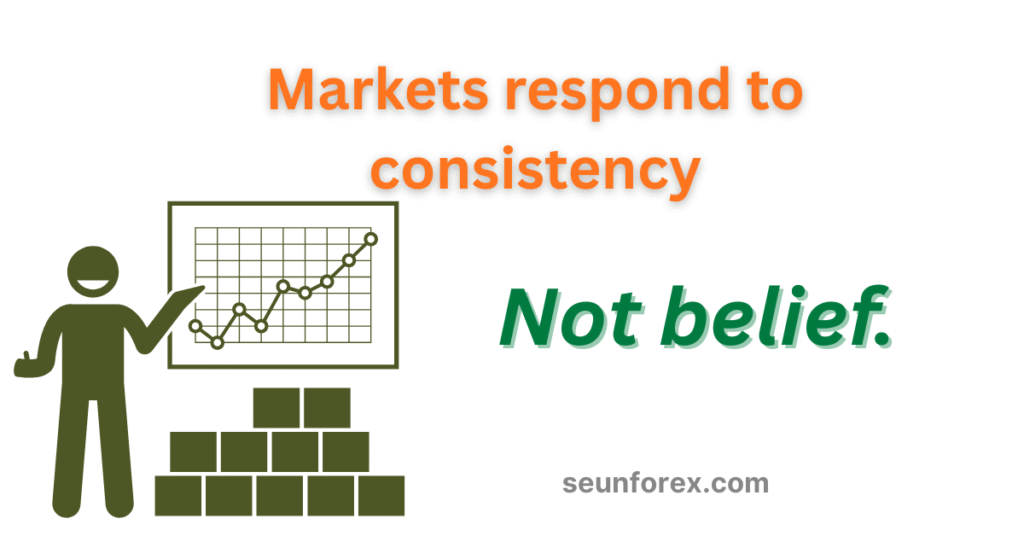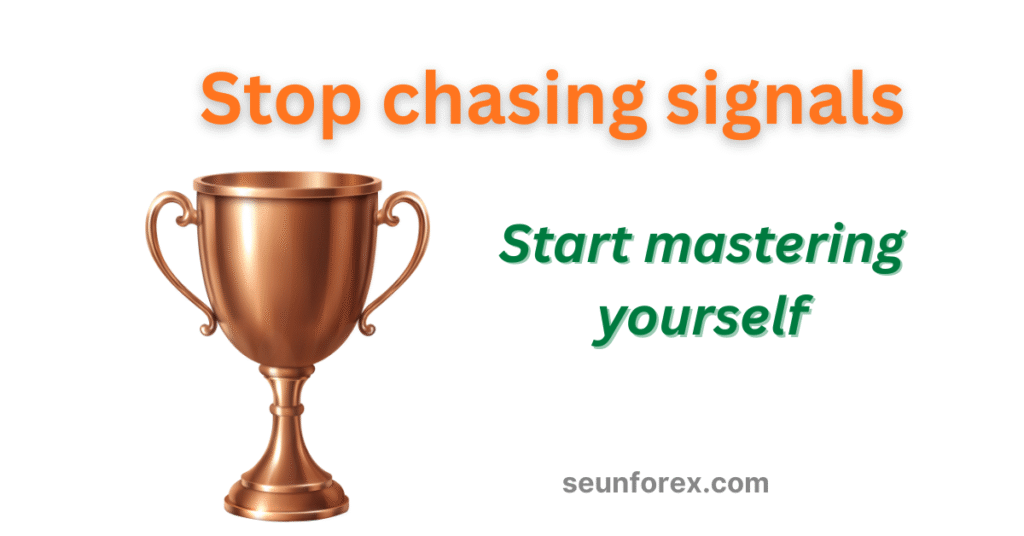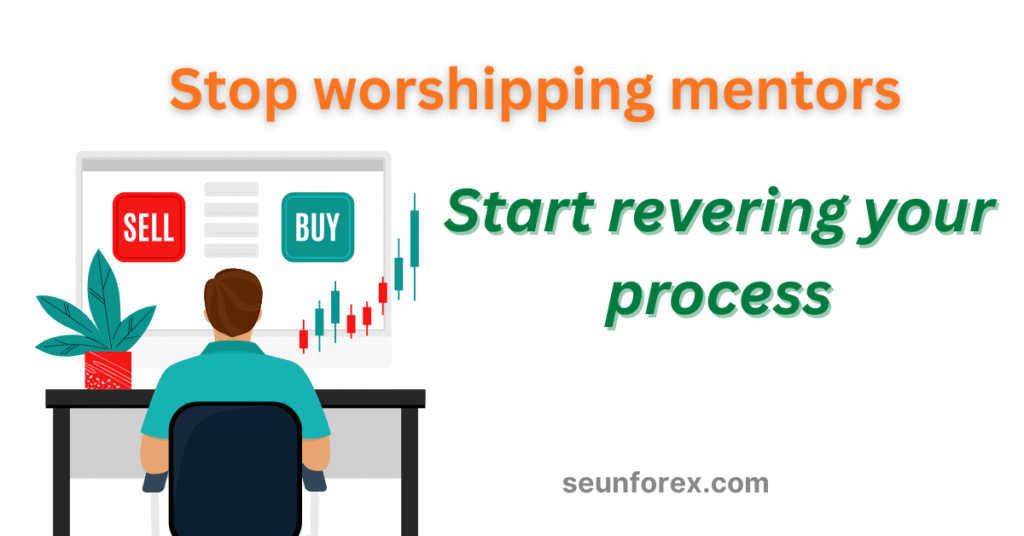
“Markets don’t reward faith — they reward observation.”
— Adapted from Mark Douglas
🚀 Trading Faith and the Illusion of Divine Guidance
The trading guru myth is alive in nearly every online trading circle. What religion and retail trading share is belief — both attract followers searching for certainty in a chaotic world. But while religion promises salvation, trading promises freedom — and both can become costly devotions when emotion replaces logic.
In every trading community, there’s always a new prophet — someone selling the “secret formula,” the “perfect signal,” or the “holy grail indicator.” This is where the trading guru myth thrives. The congregation gathers on Telegram or Discord, prays for a 90% win rate, and pays their tithes through monthly subscriptions. When losses come, they’re blamed on “lack of faith” or not following the mentor’s rules closely enough.
It’s a strange kind of spirituality — one measured in pips, not prayers.
This essay isn’t anti-mentorship; it’s anti-blindness. Every self-taught trader must learn that success doesn’t come from imitation but from iteration. You don’t need another guru; you need data, patience, and a structured simulator to refine your discipline. That simulator — your $100,000 demo account — is your testing ground, not a lottery ticket.
🔍 Section 1 — The Trading Religion: Why People Pay for Belief
Before algorithms and trading courses, there was intuition — that emotional tug telling you to buy because everyone else is buying. Human beings hate uncertainty. When faced with chaos, we look for authority. That’s why new traders fall into the trading guru myth — clinging to mentors who offer clarity, structure, and a story.
But stories can become cages.
Many traders aren’t truly seeking knowledge; they’re outsourcing responsibility. Paying for a mentor becomes psychological insurance — if the trade fails, the teacher takes the blame. That comfort costs thousands of dollars and years of lost potential.
This is the trap every self-taught trader must recognize early: the belief that wisdom can be bought instead of built. The pattern repeats endlessly:
- The mentor sells confidence.
- The student buys faith.
- The market collects tuition.
And just like organized religion, the trading guru myth grows through testimonials, not statistics. Screenshots of “withdrawals” replace scripture, and YouTube thumbnails become modern gospel icons. It’s not education; it’s entertainment disguised as expertise — the kind that keeps independent traders dependent forever.
🧠 Section 2 — The Science of Self-Learning
A $100,000 demo account can teach you more about market truth than a thousand livestreams — especially if you’ve escaped the trading guru myth. Why? Because a demo removes persuasion. In this environment, no one argues with your stop loss. No one promises certainty. You’re forced to become the scientist of your own trading process.
Imagine treating your demo like a PhD program:
- Your hypothesis is your strategy.
- Your data is your trade history.
- Your lab reports are your journals.
Each failed experiment isn’t sin; it’s feedback. You learn how spreads widen, how news slippage works, and how your emotions distort risk. This is the essence of a self-taught trader’s journey — distinguishing strategy from state of mind, discipline from belief.
That’s real enlightenment — not believing harder, but observing deeper. By embracing your demo as a laboratory, you sidestep the false promises of mentorships and the psychological traps of the trading guru myth.er.
📈 Section 3 — What a $100 k Demo Really Teaches
A demo account reveals four invisible truths:
- Execution > Prediction
You stop worshipping analysis and start worshipping process. Entries don’t matter as much as risk control and trade management. - Time Exposure > Trade Frequency
The longer you observe markets without losing money, the faster you see patterns of volatility. You learn patience is an edge. - Emotions Don’t Disappear in Demo
Even fake losses sting because ego wants to win. If you can’t stay calm on demo, you’ll collapse on live. - Consistency Beats Complexity
Simple systems repeated 500 times beat “holy grail” setups traded once a week.
Treating demo seriously transforms it from a playground into a performance mirror. When you can double a $100 k demo account without breaking rules, you’re finally ready to handle $10 k live.
📊 Section 4 — The Emotional Thrust: Your Inner Market Breadth
In Wayne Whaley’s market-momentum studies, a “thrust” signaled broad buying power. In trading psychology, emotional thrust is the same — a burst of discipline strong enough to change behavior. Escaping the trading guru myth requires learning to generate these micro-thrusts internally, without relying on external mentors.
Every trader experiences micro-thrusts of growth: a week of perfect journaling, a month without revenge trades, a day you cut losses without hesitation. These moments are statistically rare — but transformative for any self-taught trader.
If you track your discipline rate the way Whaley tracked advancing stocks, you’d see patterns emerge:
- When your discipline ratio > 70%, your equity curve follows upward.
- When it < 20%, drawdowns multiply and emotional mistakes spike.
Your goal isn’t perfection; it’s to build a forex trading mindset resilient enough to survive market swings without subscribing to the trading mentorship myth.ut momentum — creating clusters of good behavior until it becomes identity.
🔊 Section 5 — Volume of Effort: When Discipline Speaks Louder Than Faith
Traders often say they “believe” in their system. Belief is cheap; volume is proof. In market terms, volume measures commitment — how many participants actually act. In trading development, your volume of effort is how many documented trades you execute and review.
Most students quit after 100 trades. Professionals log 1 000+. The difference isn’t talent — it’s sample size.
If you record every trade in your demo journal — entry, stop, reason, emotion — you build a data set large enough to reveal truth. You stop asking gurus for certainty because you’ve measured your own.
Whaley proved that strong volume thrusts precede bull markets. In your journey, high effort thrusts precede breakthroughs. Every logged hour compounds into intuition.
💥 Section 6 — Price Thrust: Turning Practice into Profit
Price is truth. When a system finally shows statistical edge on demo — consistent profit over 300+ trades — that’s your signal thrust. But jumping to live too fast kills momentum.
Treat transition like scaling rocket stages:
- Stage 1: Demo ($100 k) — proof of concept.
- Stage 2: Micro live ($500) — proof of emotion.
- Stage 3: Mini live ($2 k–$5 k) — proof of consistency.
- Stage 4: Capitalized account — proof of maturity.
Each stage tests a different psychological layer. Skip one, and you’ll burn on re-entry.
Demo profits mean nothing until they survive pressure. But without demo profits, there’s nothing to pressure-test. That’s why the $100 k simulation is non-negotiable — it’s your flight simulator before war.

🧠 Section 7 — Combine & Conquer: The Triple-Threat Trader
Whaley combined breadth, volume, and price for a perfect record. You must combine discipline, data, and patience for the same.
The Model
- Discipline Thrust — Track rule compliance daily. Aim for 70 % or higher.
- Data Volume — Journal at least 500 demo trades.
- Performance Price — Target positive expectancy over rolling 100-trade windows.
When all three align, you’re not guessing — you’re operating.
Average result? Traders who complete this cycle report smoother equity curves, less anxiety, and fewer impulsive entries. They’ve replaced faith with evidence.
🚨 Section 8 — The Absence of Effort: When Traders Stop Learning
In Whaley’s study, years without thrusts often preceded bear markets. In personal development, months without learning or journaling precede psychological blow-ups. Falling into the trading guru myth is one of the fastest ways a trader enters this state.
A trader who stops journaling is like a chart without volume — motion without meaning. When you avoid data, you avoid truth. The silence is a signal.
Warning signs of an upcoming psychological bear market include:
- Watching mentors more than executing trades — relying on others instead of cultivating your self-taught trader mindset.
- Seeking signals immediately after losses.
- Blaming brokers for mistakes instead of reviewing your journal.
- Feeling entitled to profit without disciplined effort.
Each symptom shows you’ve outsourced agency. You’ve turned a scientific process into a faith-based exercise — exactly what the trading mentorship myth preys upon. Avoiding this trap is essential for any independent trader journey.ocess back into faith.
🧮 Section 9 — The Mentor Myth: How Gurus Create Dependency
Some mentors teach systems; others sell saviors. The difference is measured in how quickly you outgrow them.
Healthy education makes you independent within months. Toxic education keeps you dependent for years.
The business model of many “coaches” is recurrence — you must fail just enough to renew your subscription. They preach confidence but never verify equity curves. They promise freedom but create followers.
Ask yourself three questions before paying any guru:
- Can I test this myself on demo?
- Is the mentor transparent with drawdowns?
- Does their method teach decision-making or obedience?
If you can’t answer “yes” to all three, you’re buying faith, not skill.
🧪 Section 10 — The Real System: Demo, Journal, Reflect
The simplest rule-based strategy in trading psychology is this:
1. Demo Like It’s Live
Trade as if every pip feeds your family. Respect risk management to the decimal.
2. Journal Everything
Thoughts, screenshots, market conditions. Your future self is the only mentor worth paying.
3. Reflect Weekly
Identify biases — over-confidence, fear of missing out, impatience. Set numeric goals for behavior, not profit.
From 1970 to 2009, Whaley’s model had 18 profitable signals. From now to your next year, your goal is 18 profitable weeks of discipline. Every week without a major error is a winning trade in character.
✅ Key Takeaways — How to Trade Like a Self-Taught Professional
- Stop Worshipping Gurus
Mentors are useful only if they teach you to think, not to obey. Replace faith with personal data. - Your Demo Is the Real Classroom
A $100 000 demo account isn’t “fake money.” It’s simulated experience — the safest place to make expensive mistakes for free. - Journal or Die Slowly
Every trade you fail to record will repeat itself. The market punishes unmeasured emotion. - Measure Discipline, Not Profit
Profit comes from probability; probability comes from process. Your daily compliance rate matters more than your win rate. - Graduate When You Can Repeat Calmly
When you can lose without frustration, win without euphoria, and journal without skipping, you’re ready to go live.

🧭 The Paradox of Independence
The day you stop paying for “signals” and abandon the trading guru myth, you’ll notice something strange: your charts look quieter. You begin trading less and observing more, finally letting your self-taught trader instincts emerge.
Freedom in trading isn’t about doing whatever you want — it’s about having the discipline to do what works. That discipline is lonely at first. No one claps when you journal trades at 2 a.m., and no one congratulates you for avoiding a revenge entry. Yet those invisible victories are what build long-term equity and a solid forex trading mindset.
Every professional trader you admire once had a season of silence — months where nothing seemed to work, but they stayed in the lab. They stopped chasing certainty and began studying repetition. That is the essence of the independent trader journey, far removed from mentorship hype.
Here’s the hidden gospel of trading: repetition creates revelation. Only when you internalize lessons and trust your process do you escape the grip of the trading mentorship truth.
🧘♂️ The Inner Equation — Faith × Evidence = Conviction
Faith alone produces hope. Evidence alone produces logic. Combine them and you get conviction — the emotional steadiness to hold through drawdowns.
Conviction doesn’t come from motivational videos; it comes from back-tested reality. When you’ve seen your system work across 500 demo trades, belief becomes biology. Your nervous system trusts your method because it has proof.
That’s when trading becomes meditation. You’re no longer predicting; you’re observing probabilities unfold with patience.
💡 From Follower to Forecaster
The best traders don’t need forecasts; they are forecasts — because their habits predict their results.
Your trading future isn’t hidden in news releases or Fibonacci levels; it’s written in your behavior logs. A trader who reviews 20 minutes daily outperforms one who studies ten hours sporadically.
Consistency compounds faster than any signal.
When you stop following and start forecasting your own behavior, you take control of the only market you can truly master — your psychology.
⚙️ The Practical Plan — 90 Days of Trading Reinvention
Here’s a minimalistic framework you can apply starting tomorrow:
Week 1 – 2: Reset
- Delete all paid signal groups.
- Start a fresh $100 000 demo.
- Write your trading rules on paper — max risk, pairs, time frames, no-trade zones.
Week 3 – 4: Journal
- Use Google Sheets or Notion.
- Record every entry with screenshots.
- Note your emotional state before, during, and after the trade.
Month 2: Audit
- Calculate expectancy (average win × win rate – average loss × loss rate).
- Identify which setups cause 80 % of losses.
- Remove them without mercy.
Month 3: Refine
- Trade only your top-performing setups.
- Reduce frequency; increase position quality.
- End month 3 with at least 100 logged trades and one documented emotional improvement.
This 90-day program is your real mentorship — data-driven, private, free.
⚖️ The Spiritual Angle — God Doesn’t Trade for You
Faith can inspire discipline, but faith can’t replace it. Many traders pray for profit but ignore probabilities. The market is neutral; it doesn’t bless or curse — it reacts.
If you believe in divine order, see it in structure, not luck. Fibonacci, liquidity zones, and order blocks are systems of balance. Mastering them is an act of respect, not rebellion.
Trading isn’t anti-spiritual; it’s a test of stewardship. You’re not gambling God’s gift — you’re refining it.
🧭 The New Definition of “Mentor”

After months of disciplined demo work, you’ll realize mentorship has a new meaning:
- Your journal is your pastor.
- Your data is your scripture.
- Your demo account is your temple.
You visit daily, confess mistakes, and seek improvement. Every time you hit “execute,” you practice humility. Every stop-loss hit is communion with reality.
This is not sacrilegious — it’s sacred accountability.
💬 Real-World Example — The Trader Who Stopped Paying for Faith
Consider Amara, a Ghana-based trader who spent over $2,000 on mentorships that promised “institutional order flow secrets.”
Each program ended the same way — screenshots, group hype, then silence.
Out of frustration, she decided to isolate herself for three months with a $100,000 demo account. She treated it like a full-time internship:
- 400 trades logged
- 70% rule compliance
- 6% monthly simulated return
When she finally went live with $2,500, she lost only 1% in her first month — and called it “the happiest loss of my life.”
Why?
Because for the first time, she understood why she lost.
That self-awareness was worth more than every course combined.
According to Investopedia’s guide on trading psychology, emotional control and self-analysis are the core pillars of long-term profitability. A demo account gives traders that emotional laboratory — a place to practice discipline without the pain of financial loss.
Similarly, BabyPips highlights the psychological gap between demo and live trading, showing how fear and greed amplify once real money enters the equation. Amara’s story proves that mastering emotion before going live gives you an edge money can’t buy.
If you want to understand why markets seem to “hunt” your stop loss, read this in-depth breakdown:
👉 Stop Loss Hunt: HFT & Market Microstructure — it reveals the real reason why price moves the way it does and how institutions exploit liquidity pockets.
Once you understand that, you’ll stop fearing manipulation and start recognizing structure — the same structure your demo account is quietly teaching you every day.
🌍 Connecting the Dots — From Whaley to You
Wayne Whaley’s breadth and thrust model showed how collective behavior predicts market direction.
Your personal thrust model does the same: when discipline, data, and performance thrust align, your account trends upward.
You don’t need market prophecy.
You need personal alignment.
That’s the universal law of traders who last decades — self-synchronization with structure.
⚡ Final Thought — The Only Guru You Need
The next time someone sells you “God-level accuracy,” remember:
Markets have no messiah.
Discipline has no subscription.
Your $100,000 demo account is the only altar where truth reveals itself.
Trading isn’t about finding prophets — it’s about proving principles.
And when your charts get cleaner, your journals stay consistent, and your emotions go quiet — you’ll see the truth:
You’ve become the mentor you were always searching for.
Follow for More Insights:
📍 YouTube @SeunForex
📍 X @SeunForex